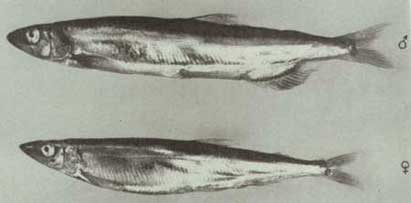Information
EMail
CoastalSafari@
CoastalSafari.com
Telephone
1-877-888-3020
(Toll free) or
709-579-3977
Mailing Address
50 Monkstown Rd. St. John's, Nfld. Canada.
A1C 3T3

Capelin (traditional Newfoundland spelling 'caplin') are the most
important forage species in the Northwest Atlantic providing a vital
link in the food chain between plankton and larger animals.
In appearance they are a small silvery fish and a close relative of the
freshwater smelt. Capelin are a cold water, pelagic, schooling species inhabiting
Arctic and sub-Arctic seas in the Atlantic and the Pacific.
Capelin spend the bulk of their lives offshore moving inshore only to spawn. Spawning takes place on beaches in June and July and attracts predators including fish, seabirds, whales, eagles and ospreys. Newfoundlanders call this the "capelin scull" and evenings in June and July will find adults and children down on the beaches equipped with buckets and dip nets to gather up this ocean bounty. Traditionally capelin were spread on gardens as fertilizer. Dried salted capelin are a traditional Newfoundland snack roasted on a stick over a camp fire.
There is a commercial fishery for capelin that provides females with roe to the Japanese market. Many Newfoundlanders believe that this is a very dangerous and wasteful fishery that should be discontinued. Every year the largest roe bearing female capelin are picked out and frozen for export to Japan. The rest, tens of thousands of tonnes of small female and male capelin are dumped out of fish processing plants into the sea. This was how the Japanese destroyed their own capelin stocks.
There is one capelin stock that spawns 200 miles offshore on a
shallow area of the south eastern Grand Banks. Biologists believe that
the spawning area was a beach during the last ice age and the capelin continued
to use the area after the sea levels rose to their present height.
The
Canadian Stock Assessment Secretariat,
provides scientific advice on capelin stocks. To read their documents
you will need Adobe Acrobat.
![]()
